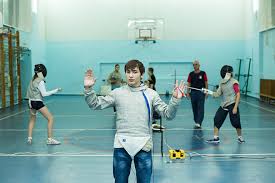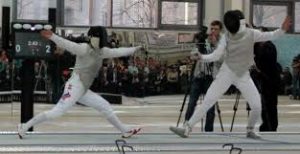repeated repetition
Stage and sports fencing
 Sports fencing is a combat sport with knives. Fencing battle is a conditional duel on edged sports weapons, regulated by the official rules of the competition. Classical fencing, subject to the rules developed by the International Fencing Federation (FIE), the elected body governing the entire international fencing sporting life, contains the following types of fencing: foil fencing, saber fencing and sword fencing.
Sports fencing is a combat sport with knives. Fencing battle is a conditional duel on edged sports weapons, regulated by the official rules of the competition. Classical fencing, subject to the rules developed by the International Fencing Federation (FIE), the elected body governing the entire international fencing sporting life, contains the following types of fencing: foil fencing, saber fencing and sword fencing.
Rapier is a piercing sporting weapon. The use of only piercing strikes and a small affected surface (compared with other types of weapons) create favorable conditions for defense and difficulty in injecting in an attack. Fencing on rapiers at a distance much shorter than on other types of weapons, and, as a rule, do not resort to deep waste, so the fencers fight are very intense. Continue reading
HYGIENIC REQUIREMENTS FOR PLACES IN THE FENCING
 Indoor facilities for fencing should primarily have sufficient floor space, cubic capacity, good ventilation and lighting. When calculating the cubic capacity, it is necessary to take into account that the pulmonary ventilation of fighters during an individual lesson and free-style fighting increases to 14.5 – 23.0 liters per minute, and the recovery period lasts for trained fencers for about 10 minutes. In Jovičkop, pulmonary ventilation remains elevated for longer. Oxygen absorption, depending on the intensity of the lesson, increases to 480.0–856.0 cm³ in 1 min. Therefore, the cubic capacity of the room per student should be considered not less than 30 m³. Ventilation devices must provide a 3-fold change in air flow, i.e. 80 – 90 m³ of air per person per hour. Continue reading
Indoor facilities for fencing should primarily have sufficient floor space, cubic capacity, good ventilation and lighting. When calculating the cubic capacity, it is necessary to take into account that the pulmonary ventilation of fighters during an individual lesson and free-style fighting increases to 14.5 – 23.0 liters per minute, and the recovery period lasts for trained fencers for about 10 minutes. In Jovičkop, pulmonary ventilation remains elevated for longer. Oxygen absorption, depending on the intensity of the lesson, increases to 480.0–856.0 cm³ in 1 min. Therefore, the cubic capacity of the room per student should be considered not less than 30 m³. Ventilation devices must provide a 3-fold change in air flow, i.e. 80 – 90 m³ of air per person per hour. Continue reading
BASIC PROVISIONS AND MOVEMENT
(Basics of fencing movement technique)
 Position “at attention” – statutory stoic, fencing weapon in the right or left hand.
Position “at attention” – statutory stoic, fencing weapon in the right or left hand.
The starting position is the position from which the transition to the fencing stand is made and in which the fighters give a greeting.
Salutation (salute) – movement with an armed hand to the opponent and the judges in greeting.
Fencing stand – the most appropriate position adopted by a fighter (or teacher) for combat or training activities. The fencing stand can vary depending on various conditions:
Common Stand – Used for training sessions.
Individually modified stance – depends on the style of combat or action. In hand-to-hand combat, a stance is used in accordance with the “to battle” position in a bayonet battle. Continue reading



